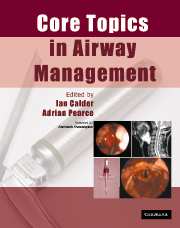Book contents
- Frontmatter
- Contents
- List of contributors
- Preface
- Acknowledgements
- List of abbreviations
- 1 Anatomy
- 2 Physiology of apnoea and hypoxia
- 3 Physics and physiology
- 4 Cleaning and disinfection of airway equipment
- 5 General principles
- 6 Maintenance of the airway during anaesthesia: supra-glottic devices
- 7 Tracheal tubes
- 8 Tracheal intubation of the adult patient
- 9 Confirmation of tracheal intubation
- 10 Extubation
- 11 Light-guided intubation: the trachlight
- 12 Fibreoptic intubation
- 13 Retrograde intubation
- 14 Endobronchial and double-lumen tubes, bronchial blockers
- 15 ‘Difficult airways’: causation and prediction
- 16 The paediatric airway
- 17 Obstructive sleep apnoea and anaesthesia
- 18 The airway in cervical trauma
- 19 The airway in cervical spine disease and surgery
- 20 The aspiration problem
- 21 The lost airway
- 22 Trauma to the airway
- 23 Airway mortality associated with anaesthesia and medico-legal aspects
- 24 ENT and maxillofacial surgery
- 25 Airway management in the ICU
- 26 The airway in obstetrics
- Index
13 - Retrograde intubation
Published online by Cambridge University Press: 15 December 2009
- Frontmatter
- Contents
- List of contributors
- Preface
- Acknowledgements
- List of abbreviations
- 1 Anatomy
- 2 Physiology of apnoea and hypoxia
- 3 Physics and physiology
- 4 Cleaning and disinfection of airway equipment
- 5 General principles
- 6 Maintenance of the airway during anaesthesia: supra-glottic devices
- 7 Tracheal tubes
- 8 Tracheal intubation of the adult patient
- 9 Confirmation of tracheal intubation
- 10 Extubation
- 11 Light-guided intubation: the trachlight
- 12 Fibreoptic intubation
- 13 Retrograde intubation
- 14 Endobronchial and double-lumen tubes, bronchial blockers
- 15 ‘Difficult airways’: causation and prediction
- 16 The paediatric airway
- 17 Obstructive sleep apnoea and anaesthesia
- 18 The airway in cervical trauma
- 19 The airway in cervical spine disease and surgery
- 20 The aspiration problem
- 21 The lost airway
- 22 Trauma to the airway
- 23 Airway mortality associated with anaesthesia and medico-legal aspects
- 24 ENT and maxillofacial surgery
- 25 Airway management in the ICU
- 26 The airway in obstetrics
- Index
Summary
Retrograde intubation is a misnomer since intubation is undertaken in the normal direction over a guide-passed retrogradely. The first description by Butler and Cirillo was of a catheter passed through a healing tracheostomy, up between the vocal cords and out of the mouth, over which a tracheal tube was railroaded. The first author to describe puncture of the intact cricothyroid membrane (CTM) was Waters (1963), then working in Africa. His method was to use a Tuohy needle to puncture the CTM, feed up ‘a yard’ of plastic tubing similar to an epidural catheter until it exited the mouth and intubate over the catheter.
A literature search in the mid-1990s revealed about 500 retrograde intubations, about 300 of which were in cadavers. Mean intubation time was about 40 s with a 98% success rate. It is, therefore, a simple, effective technique supported by a reasonable body of published work. There are two variants, namely blind and fibreoptic assisted. For the blind technique a purpose-built kit (Figure 13.1) is available from Cook Critical Care, and this will be used for description of the technique. Developments since the original description of blind retrograde by Waters have focused particularly on the guide. The epidural catheter has been replaced by a guidewire with a J-tip, with a diameter sufficient to pass through a 20-G catheter but enough stiffness to provide support for intubation. Intubation does not occur over the guidewire alone, because the difference in size between the wire and tracheal tube means that the tube tip is highly likely to impinge on the larynx. The wire is made fatter and stiffer by a bougie (or wire-stiffener) slid anterogradely, over which the tracheal tube is railroaded.
- Type
- Chapter
- Information
- Core Topics in Airway Management , pp. 105 - 108Publisher: Cambridge University PressPrint publication year: 2005
- 1
- Cited by



